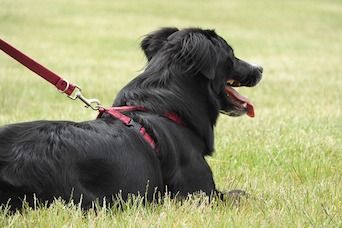What Do Guide Dog Owners Think of Their Guide Dogs?
Survey results reveal how guide dog owners perceive the behavior of their guide dogs in both working and nonworking situations.

In a survey conducted by a team of researchers in the United Kingdom, guide dog owners (GDOs) described how they view their guide dogs’ behavior. Survey results, which were published in PLoS ONE, aligned with previous findings of how pet owners perceive their pets, “suggesting that views on appropriate and inappropriate behavior may apply to both pet and working dogs,” the authors wrote.
Guide dogs serve as mobility aids to people who are blind or visually impaired. Often, they provide benefits beyond mobility support, including affection, companionship, and feelings of independence and confidence. Currently, guide dog training assessments focus on behavioral suitability (e.g., low aggressiveness, trainability). Similarly, guide dog behavior research primarily evaluates behavior through the lens of these training assessments.
GDOs comprise a demographically heterogenous population with varying needs for guide dog assistance. For this current study, the authors sought to determine which guide dog behavioral traits were important to GDOs. This information, the authors wrote, “cannot be captured in a standardized assessment and will help inform the use of [behavioral] assessments and training of guide dogs.”
Study Design
A single researcher conducted telephone interviews with 63 GDOs that currently had a working guide dog. GDOs were asked 39 questions covering several areas, including examples of guide dog behavior in work and nonwork situations. Responses were organized into a previously developed behavioral assessment framework containing 19 behavioral themes grouped into 5 categories; responses not fitting into the framework were considered to be emergent themes.
The importance of each theme was determined using several factors, including how frequently a particular behavioral issue was mentioned. Categories not mentioned by GDOs or considered as insignificant were either combined or removed from analysis.
Results
GDOs ranged widely in age (22—98 years), amount of time with the current guide dog (5 days–9 years), and number of guide dogs owned over time (1–9).
Attentiveness, obedience, confidence, and consistency were mentioned by GDOs most frequently and determined to be the most important behavioral traits. Confidence, for example, was described as particularly important for keeping both the guide dog and its owner safe from vehicular traffic. These traits helped GDOs foster a strong and trusting relationship with their dogs. In particular, one GDO remarked that “[attentiveness] makes you two sides of the same coin, you get into each other’s minds, there’s a connection between you.”
Other themes mentioned by the GDOs included eagerness/willingness to work and stress resilience. A new, emergent theme was interactions with people—particularly children—and animals.
GDOs described positive and negative aspects of their guide dogs’ behavior. For example, although many GDOs praised their dogs’ calmness (“In home he’s very good…he’s a perfect domestic animal”), they also reported moments of excitement when their dogs would become difficult to control, causing feelings of annoyance or embarrassment. Overall, GDOs considered safety in traffic as the most important positive behavior and pulling on the lead or harness as the most important negative behavior.
Conclusions and Discussion
Given the lack of research on the nonwork aspect of guide dog—GDO relationships, this study provided important insights on how GDOs perceive their dog’s behaviors in both work and social situations. In addition, study results supported the importance of matching personalities when pairing a guide dog with an owner. To ensure a good match, the authors proposed emphasizing compatibility, encouraging ongoing training, and considering GDO expectations when training guide dogs.
Dr. JoAnna Pendergrass received her Doctor of Veterinary Medicine degree from the Virginia-Maryland College of Veterinary Medicine. Following veterinary school, she completed a postdoctoral fellowship at Emory University’s Yerkes National Primate Research Center. Dr. Pendergrass is the founder and owner of JPen Communications, a medical communications company.